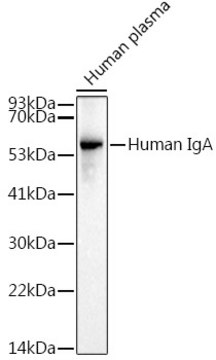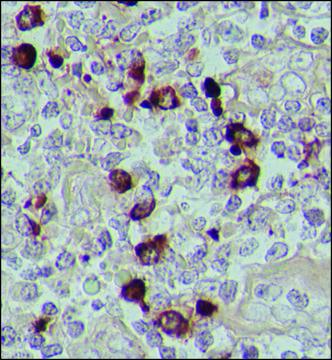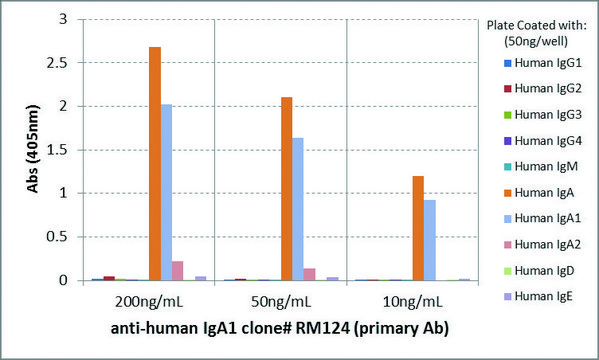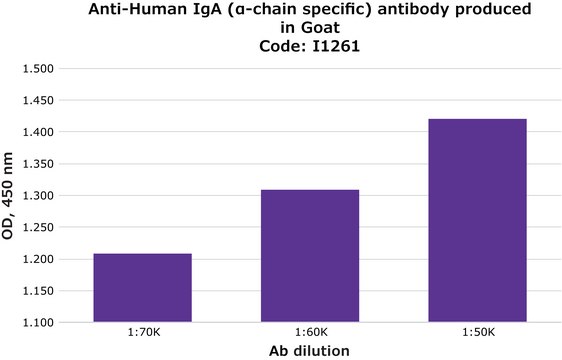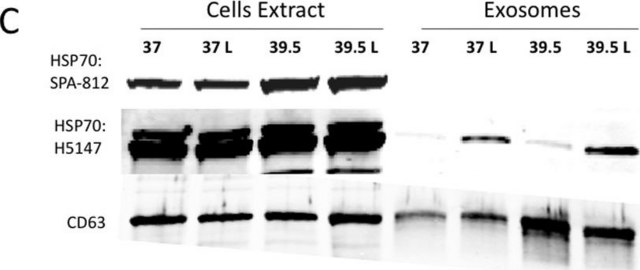SAB1303128
ANTI-IGHA1 (C-TERM) antibody produced in rabbit
IgG fraction of antiserum, buffered aqueous solution
Sign Into View Organizational & Contract Pricing
All Photos(2)
Synonym(s):
IGHA1, Ig alpha-1 chain C region
UNSPSC Code:
12352203
NACRES:
NA.41
Recommended Products
biological source
rabbit
Quality Level
conjugate
unconjugated
antibody form
IgG fraction of antiserum
antibody product type
primary antibodies
clone
polyclonal
form
buffered aqueous solution
mol wt
37655 Da
species reactivity
human
technique(s)
flow cytometry: 1:10-1:50
immunohistochemistry: 1:50-1:100
western blot: 1:250-1:500
UniProt accession no.
shipped in
wet ice
storage temp.
−20°C
Physical form
Purified polyclonal antibody supplied in PBS with 0.09% (W/V) sodium azide. This antibody is prepared by Saturated Ammonium Sulfate (SAS) precipitation followed by dialysis against PBS.
Disclaimer
Unless otherwise stated in our catalog or other company documentation accompanying the product(s), our products are intended for research use only and are not to be used for any other purpose, which includes but is not limited to, unauthorized commercial uses, in vitro diagnostic uses, ex vivo or in vivo therapeutic uses or any type of consumption or application to humans or animals.
WGK
nwg
Flash Point(F)
Not applicable
Flash Point(C)
Not applicable
Regulatory Information
新产品
Certificates of Analysis (COA)
Search for Certificates of Analysis (COA) by entering the products Lot/Batch Number. Lot and Batch Numbers can be found on a product’s label following the words ‘Lot’ or ‘Batch’.
Already Own This Product?
Find documentation for the products that you have recently purchased in the Document Library.
Hossein Aazami et al.
Allergy, asthma, and clinical immunology : official journal of the Canadian Society of Allergy and Clinical Immunology, 16, 30-30 (2020-05-01)
Chronic rhinosinusitis (CRS) describes an inflammatory condition affecting the sinonasal mucosa. As the immune system players such as immunoglobulins play prominent roles in the development of CRS, we aimed to investigate the expression of IgA subclasses and factors involved in
Lingyun Lai et al.
Discovery medicine, 28(151), 39-45 (2019-08-30)
It is widely accepted that a possible etiopathogenic factor associated with IgA nephropathy is the glycosylation of IgA1 molecule O-glycans. The present study aimed to determine if galactose-deficient IgA1 is related to glucose metabolism. IgA nephropathy was identified from the
Guoyuan Lu et al.
PloS one, 12(5), e0178352-e0178352 (2017-05-30)
IgA nephropathy (IgAN) is the most common primary glomerulonephritis characterized by human mesangial cells (HMC) proliferation and extracellular matrix expansion associated with immune deposits consisting of galactose-deficient IgA1. However, how IgA1 contributes to IgAN has yet to be completely elucidated.
Ying-Chih Chi et al.
Protein science : a publication of the Protein Society, 26(3), 600-610 (2016-12-29)
IgA1 proteases (IgA1P) from diverse pathogenic bacteria specifically cleave human immunoglobulin A1 (IgA1) at the hinge region, thereby thwarting protective host immune responses. Streptococcus pneumoniae (S. pneumoniae) IgA1P shares no sequence conservation with serine or cysteine types of IgA1Ps or
Manliu Wang et al.
Kidney international reports, 5(2), 165-172 (2020-02-12)
Galactose-deficient IgA1 (Gd-IgA1) and related IgA/IgG immune complexes have been identified as the key drivers in the pathogenesis of IgA nephropathy (IgAN). However, their roles in the development of secondary IgAN are still unknown. In this study, we measured the
Our team of scientists has experience in all areas of research including Life Science, Material Science, Chemical Synthesis, Chromatography, Analytical and many others.
Contact Technical Service